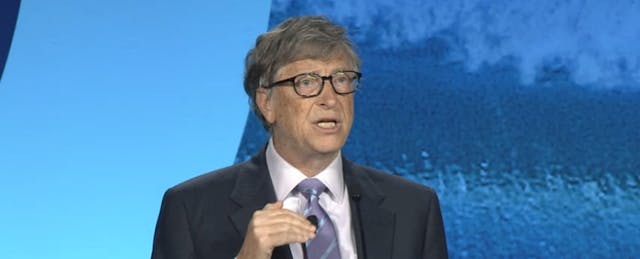Keynote speeches tend to be more inspirational than informational. But when you’re Bill Gates, and your foundation has poured billions of dollars in American education, these talks can offer a glimpse into the current and future priorities where his money may be headed.
In a packed ballroom of more than 1,000 people, Gates anchored his keynote on the closing day of the ASU+GSV Summit around the questions: Who are “the new majority” of students in American education? How do we best serve them?
The latest high school graduation rate—now at 81 percent—may look wonderful on a PowerPoint slide, or in a report, but high school is just one part of the equation. What trips students up is clearing the next hurdle: higher education. According to Gates, just 12 percent of African American, 25 percent of Hispanic, and half of white students leave K-12 schools prepared for college.
These “stunningly low” numbers, in his opinion, carry over to another dire statistic in higher education: more than half of students who attend college don’t receive a credential in six years.
The demographics of college-goers are also changing, Gates shared. Forty percent of students in higher education are over the age of 25, and one-third are the first in their family to go to college. These learners are what he calls “the new majority.”
Re-emphasizing a recurring theme at this conference, Gates tied these statistics to implications for the workforce and U.S. economy. By 2025, two-thirds of jobs will require a postsecondary degree, according to the Georgetown Center on Education and the Workforce. But at the current rate, there will be a shortfall of 11 million students with higher-ed credentials to fill those jobs.
Coding bootcamps and other alternative education providers may offer new bridges that connect education and employment. But “we also need to focus within the [education] system, and understand why technology doesn’t scale.”
Here’s how Gates categorized his foundation’s education priorities—and the funded projects that got coveted shoutouts:
Effective personalized learning solutions: In the K-12 market, hat tip went to Big History Project (now used in 1,200 schools) for “redefining how kids engage in science,” taught through the lens of eight billion years of history. NewClassrooms and ThinkCERCA also got nods for creating engaging learning experiences for students in math and literacy, respectively.
In higher education, Gates lauded efforts to improve remedial courses that “far too many students have to take.” His foundation, he added, has spent over $50 million over the past seven years to work with state leaders to redesign these experiences. And through competitions like the Next Generation Courseware Challenge, the foundation supports startups like Acrobatiq, Smart Sparrow and Lumen Learning working with early-adopter colleges to build personalized learning experiences. There’s also a need for new advising tools such as iPass, he noted, that help under-supported students better plan their courses.
Building an evidence base of what works: With the proliferation of edtech tools and services, Gates raised the need for tools to understand what works. In addition to organizations like LEAP Innovations, which connects developers and teachers to run trials to evaluate projects, “we have online sites like Graphite and EdSurge that share experiences people have.” (Thanks, Bill.)
“To move to this evidence-based approach,” Gates acknowledged, “investors will have to take a longterm approach. For entrepreneurs, it means deep engagement with educators. And for district leaders, it means being willing to be involved with pilots.”
Adoption of proven education technologies: “I believe that within the next five years, the vast majority of schools should have one aspect of their program that are using personalized learning,” Gates predicted. He gushed over Summit Public Schools and Next Generation Learning Challenges for “building a spirit of collaboration among innovators.”
“I was amazed in my last visit to Summit,” Gates offered, saying he liked how the California-based charter school “gave students some degree of choice and an idea what they have to get done. The idea of agency….creates a very different relationship between the student and teacher.”
In education, there are two types of school visits, he added. “When you get discouraged and don’t think anything can happen, visit KIPP, Green Dot Public Schools, Summit, Rocketship, High Tech High” to get inspired, he said. “Then, if you think that’s great, visit a college with a 19 percent completion rate.”
This juxtaposition between inspiring efforts and deflating realities, Gates noted, is what drives his mission. “We have plenty of opportunities to visit both.”


